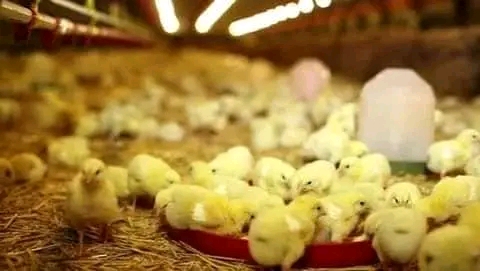RAISING DAY OLD CHICKS TO GROWERS
■Day 1-day 7
- The chicks need to be in a brooder.
What is a Brooder?
- a brooder is a simple construction that is used to raise chicks until a point they are not so vulnerable.
- brooders maybe small rooms, wood construction, brooder boxes etc.
- chicks should stay in a brooder for at least 3 weeks - 4 weeks
●How to make a good brooder!
- make sure the brooder is not cold. ( provide source of heat ie. 100,watts Bulb, hot water bottles, brooder pots, etc)
- consider constructing brooders that's not too big and not too small.
-clean and disinfect the brooder before receiving chicks
- provide enough drinkers and enough feeders
- make sure the brooder is free from insects, rodents and mature chicken.
- provide dry dusting materials (saw dust or rice husks).
■Feeding chicks between day 1-day 7
- the best feed at this age is starter (crumbs or mash). - starter crumbs
- fugo starter mash
- pembe starter mash
- at this age avoid mixing of the feed with jenga, omena, pellets etc. You can mix starter crumbs and starter mash at a proportional ration.
- Avoid feeding broiler starter crumbs for chicks that are not broilers.
●Drugs .
- chick formula (egocin,veta chick start, poltricin, vitamet chick etc, dosage (one teaspoon for 5lts, ½teaspoon for 2 litres and ¼teaspoon for one litre)
- aliseryl (this is a blend of various vitamins that will help your chicks grow fast with strength and energy. Also helps chicks boost the appetite and also helps in preventing numerous diseases). Dosage same as chick formula
- liquid paraffin- this is not the normal paraffin we use at homes. This is a medicated paraffin that helps relieve constipation, helps in digestion, prevents injuries to alimentary canal and helps chicks to pass soft droppings.
- so week one give a combinations of chick formula, aliseryl and liquid paraffin
■Give Newcastle at day 7_
Day 8- day 14
■Feeds
-Same as previous week
-
●Drugs
-continue with chick formula
- use coccidiostat (biosol, coccid, vetatrim, biotrim etc) in place of aliseryl. This will help to prevent coccidiocis.
- drop liquid paraffin
so, second week you give a combination of coccid+chick formula
-give gumboro vaccine at day 14
■Day 15- day 21
- feed as previous week
●Drugs
- combination of vitamin and antibiotics ( aliseryl, neoxy vitamin, miramed, agranyl etc)
- repeat Newcastle vaccine
■Day 22- day 28
●Feed .
Start introducing chick mash. (Mixing chick mash with starter )
- incase you started with crumbs, continue giving crumbs until they are 7 weeks old.
●Drugs
- give coccidiostat
- repeat gumboro at day 28.
■Week 5.
Here the chicks are old enough and can survive out of the brooder.
●Feeds
- chick mash/ chick crumbs( or mixture of mash and crumbs)
●Drugs
- vitamins.
■Week 6
Feeds- as in week 5
Drugs, coccidiostat and strexia
●Vaccinate fowl pox._
■Week 7
●Feeds
- gradually introduce growers( mix chick mash and growers)
- drugs - feed suppliments ie molar plus, vigosine or tonophos.
■Week 8
Feeds, growers mash( you can mix with pellets, omena, jenga etc)
10 kgs of growers (mixed rations)
.- 6kgs growers mash
- 1kg jenga
- 1kg omena
-1 kg pellets
- 1/2 kg ngano
-¼kg sunflower
-¼kg cotton
●Drugs
-vitamins and antibiotics
-vaccinate fowl typhoid.
Follow up Abdulrafeeh Abdulkareem
#broiler #feed #feeding #chicken #farming #farmlife #farmer #farm #farmersmarket #Agriculture #Agricultural #agriculturelife #agri #pullet
■Day 1-day 7
- The chicks need to be in a brooder.
What is a Brooder?
- a brooder is a simple construction that is used to raise chicks until a point they are not so vulnerable.
- brooders maybe small rooms, wood construction, brooder boxes etc.
- chicks should stay in a brooder for at least 3 weeks - 4 weeks
●How to make a good brooder!
- make sure the brooder is not cold. ( provide source of heat ie. 100,watts Bulb, hot water bottles, brooder pots, etc)
- consider constructing brooders that's not too big and not too small.
-clean and disinfect the brooder before receiving chicks
- provide enough drinkers and enough feeders
- make sure the brooder is free from insects, rodents and mature chicken.
- provide dry dusting materials (saw dust or rice husks).
■Feeding chicks between day 1-day 7
- the best feed at this age is starter (crumbs or mash). - starter crumbs
- fugo starter mash
- pembe starter mash
- at this age avoid mixing of the feed with jenga, omena, pellets etc. You can mix starter crumbs and starter mash at a proportional ration.
- Avoid feeding broiler starter crumbs for chicks that are not broilers.
●Drugs .
- chick formula (egocin,veta chick start, poltricin, vitamet chick etc, dosage (one teaspoon for 5lts, ½teaspoon for 2 litres and ¼teaspoon for one litre)
- aliseryl (this is a blend of various vitamins that will help your chicks grow fast with strength and energy. Also helps chicks boost the appetite and also helps in preventing numerous diseases). Dosage same as chick formula
- liquid paraffin- this is not the normal paraffin we use at homes. This is a medicated paraffin that helps relieve constipation, helps in digestion, prevents injuries to alimentary canal and helps chicks to pass soft droppings.
- so week one give a combinations of chick formula, aliseryl and liquid paraffin
■Give Newcastle at day 7_
Day 8- day 14
■Feeds
-Same as previous week
-
●Drugs
-continue with chick formula
- use coccidiostat (biosol, coccid, vetatrim, biotrim etc) in place of aliseryl. This will help to prevent coccidiocis.
- drop liquid paraffin
so, second week you give a combination of coccid+chick formula
-give gumboro vaccine at day 14
■Day 15- day 21
- feed as previous week
●Drugs
- combination of vitamin and antibiotics ( aliseryl, neoxy vitamin, miramed, agranyl etc)
- repeat Newcastle vaccine
■Day 22- day 28
●Feed .
Start introducing chick mash. (Mixing chick mash with starter )
- incase you started with crumbs, continue giving crumbs until they are 7 weeks old.
●Drugs
- give coccidiostat
- repeat gumboro at day 28.
■Week 5.
Here the chicks are old enough and can survive out of the brooder.
●Feeds
- chick mash/ chick crumbs( or mixture of mash and crumbs)
●Drugs
- vitamins.
■Week 6
Feeds- as in week 5
Drugs, coccidiostat and strexia
●Vaccinate fowl pox._
■Week 7
●Feeds
- gradually introduce growers( mix chick mash and growers)
- drugs - feed suppliments ie molar plus, vigosine or tonophos.
■Week 8
Feeds, growers mash( you can mix with pellets, omena, jenga etc)
10 kgs of growers (mixed rations)
.- 6kgs growers mash
- 1kg jenga
- 1kg omena
-1 kg pellets
- 1/2 kg ngano
-¼kg sunflower
-¼kg cotton
●Drugs
-vitamins and antibiotics
-vaccinate fowl typhoid.
Follow up Abdulrafeeh Abdulkareem
#broiler #feed #feeding #chicken #farming #farmlife #farmer #farm #farmersmarket #Agriculture #Agricultural #agriculturelife #agri #pullet
RAISING DAY OLD CHICKS TO GROWERS
■Day 1-day 7
- The chicks need to be in a brooder.
What is a Brooder?
- a brooder is a simple construction that is used to raise chicks until a point they are not so vulnerable.
- brooders maybe small rooms, wood construction, brooder boxes etc.
- chicks should stay in a brooder for at least 3 weeks - 4 weeks
●How to make a good brooder!
- make sure the brooder is not cold. ( provide source of heat ie. 100,watts Bulb, hot water bottles, brooder pots, etc)
- consider constructing brooders that's not too big and not too small.
-clean and disinfect the brooder before receiving chicks
- provide enough drinkers and enough feeders
- make sure the brooder is free from insects, rodents and mature chicken.
- provide dry dusting materials (saw dust or rice husks).
■Feeding chicks between day 1-day 7
- the best feed at this age is starter (crumbs or mash). - starter crumbs
- fugo starter mash
- pembe starter mash
- at this age avoid mixing of the feed with jenga, omena, pellets etc. You can mix starter crumbs and starter mash at a proportional ration.
- Avoid feeding broiler starter crumbs for chicks that are not broilers.
●Drugs .
- chick formula (egocin,veta chick start, poltricin, vitamet chick etc, dosage (one teaspoon for 5lts, ½teaspoon for 2 litres and ¼teaspoon for one litre)
- aliseryl (this is a blend of various vitamins that will help your chicks grow fast with strength and energy. Also helps chicks boost the appetite and also helps in preventing numerous diseases). Dosage same as chick formula
- liquid paraffin- this is not the normal paraffin we use at homes. This is a medicated paraffin that helps relieve constipation, helps in digestion, prevents injuries to alimentary canal and helps chicks to pass soft droppings.
- so week one give a combinations of chick formula, aliseryl and liquid paraffin
■Give Newcastle at day 7_
Day 8- day 14
■Feeds
-Same as previous week
-
●Drugs
-continue with chick formula
- use coccidiostat (biosol, coccid, vetatrim, biotrim etc) in place of aliseryl. This will help to prevent coccidiocis.
- drop liquid paraffin
so, second week you give a combination of coccid+chick formula
-give gumboro vaccine at day 14
■Day 15- day 21
- feed as previous week
●Drugs
- combination of vitamin and antibiotics ( aliseryl, neoxy vitamin, miramed, agranyl etc)
- repeat Newcastle vaccine
■Day 22- day 28
●Feed .
Start introducing chick mash. (Mixing chick mash with starter )
- incase you started with crumbs, continue giving crumbs until they are 7 weeks old.
●Drugs
- give coccidiostat
- repeat gumboro at day 28.
■Week 5.
Here the chicks are old enough and can survive out of the brooder.
●Feeds
- chick mash/ chick crumbs( or mixture of mash and crumbs)
●Drugs
- vitamins.
■Week 6
Feeds- as in week 5
Drugs, coccidiostat and strexia
●Vaccinate fowl pox._
■Week 7
●Feeds
- gradually introduce growers( mix chick mash and growers)
- drugs - feed suppliments ie molar plus, vigosine or tonophos.
■Week 8
Feeds, growers mash( you can mix with pellets, omena, jenga etc)
10 kgs of growers (mixed rations)
.- 6kgs growers mash
- 1kg jenga
- 1kg omena
-1 kg pellets
- 1/2 kg ngano
-¼kg sunflower
-¼kg cotton
●Drugs
-vitamins and antibiotics
-vaccinate fowl typhoid.
Follow up Abdulrafeeh Abdulkareem
#broiler #feed #feeding #chicken #farming #farmlife #farmer #farm #farmersmarket #Agriculture #Agricultural #agriculturelife #agri #pullet
0 Comments
0 Shares
0 Reviews








